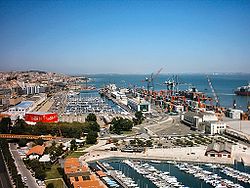Lisbon Region (Portuguese: Região de Lisboa, IPA: [ʁɨʒiˈɐ̃w dɨ liʒˈβoɐ]) is one of the seven NUTS II designated regions of Portugal, which coincides with the NUTS III subregion Lisbon Metropolitan Area. The region covers an area of 3001.95 km2 (the smallest region on mainland Portugal) [3] and includes a population of 2,815,851 inhabitants according to the 2011 census (the second most populated region in Portugal after the Norte region),[4] a density of 1039 inhabitants/km2.
Lisbon Região de Lisboa | |
|---|---|
 The port of Lisbon, the terminus of activities in the Region of Lisboa, that extends into Tagus estuary | |
| Etymology: Lisboa, Portuguese for Lisbon | |
 Location of the Lisbon Region in context of the national borders | |
| Country | |
| Capital | Lisboa |
| Area | |
| • Total | 3,001.95 km2 (1,159.06 sq mi) |
| Population (2011) | |
| • Total | 2,815,851 (2nd) |
| GDP | |
| • Total | €87.368 billion (2022) |
| • Per capita | €30,642 (2022) |
| Time zone | UTC+0 (WET) |
| • Summer (DST) | UTC+1 (WEST) |
| ISO 3166 code | PT-11 |
| NUTS | PT17 |
| Statistics from INE (2005); geographic detail from Instituto Geográfico Português (2010) | |
Considered as representing the Lisbon Metropolitan Region. It is a region of significant importance in industry (light and heavy), services, and it is highly urbanized. The gross domestic product (GDP) of the region was 73.3 billion euros in 2018, accounting for 36% of Portugal's economic output. GDP per capita adjusted for purchasing power was 30,200 euros or 100% of the EU27 average in the same year. The GDP per employee was 92% of the EU average.[5]
History edit
Prior to 2002, the area was included within the NUTS II region of Lisbon and Tagus Valley (that also included three other subregions). Before 2015, the region was divided into two NUTS III subregions: Grande Lisboa and Península de Setúbal.
NUTS II region and area of intervention of the CCDRLVT edit
"Despite the territorial configuration for statistical purposes (National Statistical System in Portugal), in force since 2002, matching the NUTS II the Lisbon, Region Greater Lisbon (AML) - composed only NUTSIII Greater Lisbon and Setúbal Peninsula - the area of intervention of the CCDRLVT - Steering Committee and Regional Development, abbreviated to CCDR - (the Lisbon and the Tagus Valley), continues to be composed of 5 NUTSIII (Sub-regions: Greater Lisbon, Setúbal Peninsula, Middle Tagus, and Lezíria West Coast).
For the Regional Funds, management responsibilities under the policy of the European Union in Portugal, this regions it's the region of Lisbon that consists of Grande Lisboa and Península de Setúbal, for regional planning (Run, monitor and evaluate, at regional level, policies on environment, nature conservation, land management and city) the region is called Lisbon and the Tagus Valley (LVT), composed by 5 NUTSIII (Sub-regions: Greater Lisbon, Setúbal Peninsula, Middle Tagus, and Lezíria West Coast)."
Municipalities edit
| Municipality | Area (km2) | Population (2011) | Pop. Density (hab./km2) | Freguesias | Statistical subregion |
|---|---|---|---|---|---|
| Alcochete | 128.36 | 17,569 | 136.8 | 3 | Península de Setúbal |
| Almada | 70.21 | 174,030 | 2,478.7 | 11 | Península de Setúbal |
| Amadora | 23.79 | 175,136 | 7,361.7 | 11 | Grande Lisboa |
| Barreiro | 36.39 | 78,764 | 2,164.4 | 8 | Península de Setúbal |
| Cascais | 97.4 | 206,479 | 2,119.9 | 6 | Grande Lisboa |
| Lisbon | 100.1 | 489,562 | 5,474.6 | 24 | Grande Lisboa |
| Loures | 167 | 199,494 | 1,154 | 18 | Grande Lisboa |
| Mafra | 291.5 | 70,867 | 243 | 17 | Grande Lisboa |
| Moita | 54.6 | 71,596 | 1,311 | 6 | Península de Setúbal |
| Montijo | 340.5 | 41,432 | 122 | 8 | Península de Setúbal |
| Odivelas | 26.6 | 153,584 | 5,774 | 7 | Grande Lisboa |
| Oeiras | 45.8 | 172,021 | 3,756 | 10 | Grande Lisboa |
| Palmela | 465.9 | 62,820 | 135 | 5 | Península de Setúbal |
| Seixal | 95.7 | 184,269 | 1,837 | 6 | Península de Setúbal |
| Sesimbra | 195.7 | 52,371 | 268 | 3 | Península de Setúbal |
| Setúbal | 193.6 | 124,459 | 643 | 8 | Península de Setúbal |
| Sintra | 319.4 | 377,835 | 1,396 | 20 | Grande Lisboa |
| Vila Franca de Xira | 323.5 | 142,163 | 439 | 11 | Grande Lisboa |
| Total | 2,962.4 | 2,819,433 | 952 | 211 |
References edit
- Notes
- ^ "Produto interno bruto (B.1*g) a preços correntes (Base 2016 - €) por Localização geográfica (NUTS - 2013); Anual". www.ine.pt. Retrieved 3 September 2023.
- ^ "Produto interno bruto (B.1*g) por habitante a preços correntes (Base 2016 - €) por Localização geográfica (NUTS - 2013); Anual". www.ine.pt. Retrieved 3 September 2023.
- ^ Statistical Yearbook of Portugal 2012. Instituto Nacional de Estatística. p. 50.
- ^ "Censos 2011 Resultados Preliminares 2011". INE.
- ^ "Regional GDP per capita ranged from 30% to 263% of the EU average in 2018". Eurostat.
- Sources
- CCDR-LVT (2010). "CCDR-LVT" (in Portuguese). Lisbon, Portugal: Comissão de Coordenação e Desenvolvimento Regional. Archived from the original on 2011-01-21. Retrieved 2011-02-03.